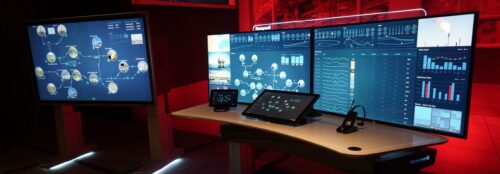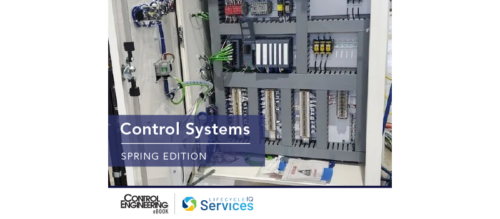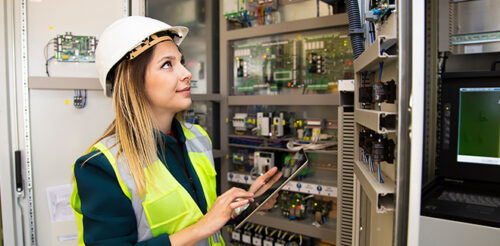Vintage Boilers Get Upgrade
Oklahoma State University had five 1949-vintage, multi-burner boilers using old Bailey pneumatic controls. The long-obsolete Bailey large-case pneumatics were difficult and expensive to maintain, inaccurate and not repeatable, but very easy to operate, and very, very reliable. MicroMod Automation Inc.
Oklahoma State University had five 1949-vintage, multi-burner boilers using old Bailey pneumatic controls. The long-obsolete Bailey large-case pneumatics were difficult and expensive to maintain, inaccurate and not repeatable, but very easy to operate, and very, very reliable.
MicroMod Automation Inc. and Frank Lill & Son Inc. of Rochester, NY, delivered 84-85% efficiency and significant fuel savings by integrating a state-of-the-art combustion control system.
Oklahoma State University (OSU), one of the nation’s leading land-grant universities located in Stillwater, has five boilers ranging from 40,000 to 125,000 lb/hr. All were originally designed to run on oil and natural gas, although at least one boiler never had been fired on oil.
For the retrofit, OSU developed a detailed specification that called for a general contractor with a least 5 years’ experience in design, installation, and commissioning of at least 50 boiler control system projects. The contractor was to be responsible for demolition of existing control panels, removal of all pneumatic piping and instrumentation, installation of new field instruments and an operators’ booth, and design of the new combustion control system. As the winning contractor, Frank Lill & Son partnered with MicroMod Automation Inc., who would be responsible for the boiler controls.
Modular design
MicroMod replaced each boiler’s aging pneumatic controls with a fully-metered combustion control system with cross-limits and O2 trim, and a Common Plant Master panel. Its modular system was integrated into a graphical operator interface with data historian capabilities. They also selected and supplied the field instrumentation, including multivariable transmitters and videographic recorders from ABB, and performed commissioning, startup, and training on the new control system.
Each boiler control panel includes six Mod 30ML multiloop controllers from MicroMod for the combustion controls and three-element drum level. Using the excess O2 signal, the controllers continuously adjust the air/fuel ratio to compensate for changes in fuel heating value, ambient air, mechanical wear and tear, and other variables that can affect combustion efficiency. Controllers provide on-line boiler efficiency calculations, and the system monitors steam distribution for billing to various university departments.
The Common Plant Master panel has nine Mod 30ML controllers for deaerator tank level, pressure reducing stations, and feedwater pump pressure. A redundant Plant Master tracks the primary controller and takes over Plant Master functions if required. Data transfer between controllers is done over a secure, token-passing network separate from the network carrying information to human machine interface (HMI) software.
Workstations, flatscreens
MicroMod provided a new operator workstation with two flat-screen monitors using Genesis32 software from Iconics. Located in the new operator booth, the HMI system allows operators to simultaneously view graphics, such as trends and controller faceplate mimics, multiple boilers, plant overview, a single boiler, and the like. An engineering workstation in the supervisor’s office provides the same viewing capability, reporting, and Visual Application Designer software to graphically create, edit, save, download, and document the Mod 30ML controller databases. Communications between controllers and PCs is via Modbus RS-485 and an Ethernet network with RJ45 connections.
The two integrated elements of the control system—the MOD 30ML and the Gen-32 HMI software—provide OSU personnel with security and integrity of traditional panelboard control architecture, along with sophistication, state-of-the-art technology, trending, and data acquisition capabilities.
A major project requirement was maintaining the Master Control Panel functions while the conversion to the new control system took place. With MicroMod and OSU Utilities Department personnel working together, the process of transferring functions from existing control locations to temporary controls using I/Ps (current-to-pneumatic connections), and then to the new Master panel, was successfully completed.
Mechanical corrections
MicroMod also assisted OSU in improving the overall boiler operation by uncovering mechanical installation issues that could contribute to inconsistent combustion performance. Four electrical generation turbines were incorporated into the system, providing previously unavailable graphical operation and data collection.
Maintaining a “traditional” loop architecture meant operators adapted quickly to the new system. MicroMod conducted three-phase training with field and classroom sessions, which were videotaped and delivered to OSU on CD-ROM along with complete system documentation. During this process OSU operators were able to document boiler operating procedures, update them to take advantage of new functionality, and create an “Operator Reference Handbook” for their system.
The boiler operators have seen improvements in the operation of the boilers, which are currently running at maximum efficiency for the fuel types.
Do you have experience and expertise with the topics mentioned in this content? You should consider contributing to our CFE Media editorial team and getting the recognition you and your company deserve. Click here to start this process.





